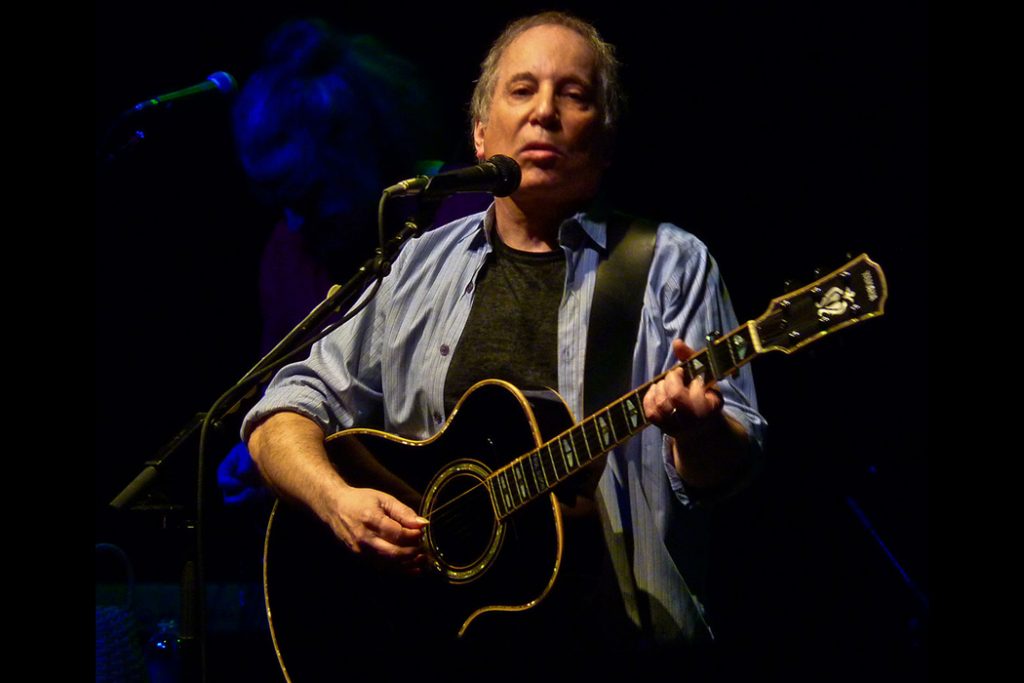
+ Improve your songwriting with Soundfly! Explore our range of courses on emotional chord progressions, basic songwriting technique, songwriting for producers, and many more. Subscribe for unlimited access here.
By Eric Dickstein
“Tonight I’ll sing my songs again,
I’ll play the game and pretend.
But all my words come back to me in shades of mediocrity.
Like emptiness in harmony I need someone to comfort me.
Homeward bound,
I wish I was homeward bound”
52 years later, Paul Simon’s wish in “Homeward Bound” has finally come true. On September 22nd, Paul Simon played the final show of his Farewell Tour at Flushing Meadows-Corona Park in Queens, New York, a 20-minute bike ride from his childhood home.
Simon was born in 1941 in Newark, New Jersey to Hungarian-Jewish parents, but he grew up in Forest Hills, Queens, only three blocks from Art Garfunkel. When Simon was 11 years old, the two met in a school production of Alice in Wonderland. They hit it off and began performing as the duo Tom and Jerry. While they were in high school, Simon and Garfunkel recorded their first single “Hey, Schoolgirl,” which launched their songwriting career, having sold over 100,000 copies and landing them on American Bandstand, a popular American music and dance TV program hosted by Dick Clark.
The duo went their separate ways in college, breaking up for the first of many times in their career. Simon studied English at Queens College in New York where he was classmates with Carole King. With King on the piano and drums and Simon playing the bass and guitar, the two made demos for record companies at $25 a piece.
Simon reunited with Garfunkel in 1964, after graduating, to record their first full length album, Wednesday Morning 3am. The album did not receive much traction, however. Taking another break from that project, Simon moved to England and dedicated himself to working on his first solo record, The Paul Simon Songbook.
Despite the initial flop of Wednesday Morning 3am, radio stations on the east coast began to get listener requests for “The Sound of Silence.” Tom Wilson, the producer of the album, recognized its greater potential and overdubbed the original track with bass, drums, and electric guitar. In 1965, he then released it as a single without Simon’s knowledge or consent. Though Wilson’s additions helped the song finally climb to #1 on the Billboard Pop Charts and launched Simon to overnight stardom, he was horrified when he first heard the updated version.
With some newfound success, Simon returned to the US and reunited with Garfunkel. They worked on the soundtrack for the film The Graduate together, and recorded three more albums between 1966 and 1968: Sounds of Silence; Parsley, Sage, Rosemary and Thyme; and Bookends. This creative deluge of work, across three solidly brilliant albums, solidified Simon and Garfunkel as one of the most popular folk-rock duos of the time, and would eventually position them as multi-generational influencers.
In 1970, Simon and Garfunkel released Bridge Over Troubled Water. It was a hit and won the duo a Grammy Award for “Best Album” of that year. Even so, this would be the final Simon and Garfunkel studio record. Imagine that for a second, because history tends to blur details such as this — at the peak of their popularity, the two broke up, once again. This eventually allowed Garfunkel to fully pursue an acting career and Simon to return to his solo work.
Though the two songwriters would reunite a few more times down the road, for isolated performances and tours here and there, they could never really set aside their personal issues; and they never stayed together for any substantial period.
Paul Simon released masterpiece after masterpiece throughout the rest of the 1970s, each album displaying inventive lyricism, elegant harmony, and distinctive attention to detail. But it wasn’t until the ’80s that Simon would secure his place among the greats of music history…
Following his divorce with actress Carrie Fisher and the devastating commercial failure of his 1983 album, Hearts and Bones, Paul Simon was at a low point in his life and career. But it was this inner turmoil inspired some of Simon’s most poignant and refined poetry. He traveled to South Africa for inspiration to create what many consider his magnum opus, the 1986 record, Graceland, where he collaborated with many local musicians.
This album effortlessly mixes rock and pop with Zulu and Xhosa musical styles such as mbaqanga and isicathamiya. The lead single off this album, “You Can Call Me Al,” reached into the top five on seven countries’ music charts.
After Graceland, Simon made a similar trip to Brazil to create The Rhythm of the Saints — a medley of Simon’s folk roots with Brazilian percussion. He then worked on the musical play, The Capeman, with Derek Walcott throughout the 1990s. The show itself was a failure, and Simon’s career was once again at a low point, but he continued to pursue a quest to remain relevant and continued innovating however he could. In 1999, he reentered the national spotlight, doing a national tour with Bob Dylan.
Since that tour, Simon has released five more studio albums, including his 2011 release, So Beautiful or So What, which many critics believe to be his strongest album in 20 years. It truly is a great album, reflecting both his experience from a lifetime of writing songs, combined with the freshness of his persistent quest for reinvention.
Despite the fact that Simon is one of the most highly-regarded songwriters alive, his career path has never been linear. In fact, most artists’ careers never really follow straight lines. Simon’s has been filled with ups-and-downs, fallings-out, mediocre albums, and one hugely expensive musical theater production. When Simon failed, however, he brought a meticulousness and honesty that must be respected.
Even at the end of his career, Simon continues to display a beautiful sensibility and distinctive attention to detail. In September of this year, Simon released In the Blue Light, a collection of back-catalog songs that he believes he did not get right the first time. Many of the differences are subtle and will only be noticed by die-hard fans. That being said, for Simon, it’s about the craft. He has always created for himself. And just like his career, he’s ending on his own terms: when he wants, and in his hometown.
This is why Simon has managed to be successful throughout so many decades. He never writes with the goal of producing a “pop hit” — instead, his strength lies in his ability to capture a moment, in transforming the mundane into the profound. When he describes meeting his old lover on the street last night, or sitting with Julio down by the schoolyard, Simon propels you into the character portraits he paints, or specific times and places in his life. And as we listen to Simon struggling to make sense of himself and his experiences, he in turn helps us to understand ourselves better, as well.
52 years after “Homeward Bound” was first released, Simon finally is home. Singing “Homeward Bound” for one last time, on the big stage only a stone’s throw from his childhood stomping grounds, it felt like the symbolic tying of a knot. And in his epic quest homeward, Simon has simultaneously established a sense of home for so many.
Though Simon’s career formally ended that night in September, his music will live on in the memories his songs create and the relationships they define. Forget his 16 Grammys — that is the sign of true success.
Get 1:1 coaching on your songwriting from a seasoned pro.
Soundfly’s community of mentors can help you set the right goals, pave the right path toward success, and stick to schedules and routines that you develop together, so you improve every step of the way. Tell us what you’re working on, and we’ll find the right mentor for you!
—
 Eric Dickstein is a NYC-born musician, currently studying at Georgetown University. He plays keys, sings, and writes music for the soul-pop group Melt. Eric is also the Associate Editor of The 11 Contracts That Every Artist, Songwriter, and Producer Should Know by Steve Gordon, a book on how to navigate contracts in the music industry.
Eric Dickstein is a NYC-born musician, currently studying at Georgetown University. He plays keys, sings, and writes music for the soul-pop group Melt. Eric is also the Associate Editor of The 11 Contracts That Every Artist, Songwriter, and Producer Should Know by Steve Gordon, a book on how to navigate contracts in the music industry.




